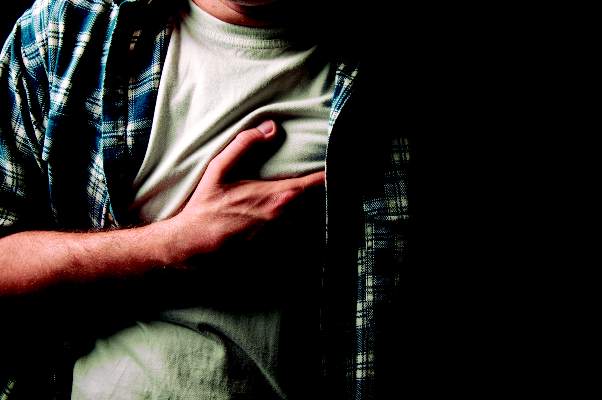User login
Noninvasive testing in the emergency department of patients who have chest pain and have not had a myocardial infarction can result in overdiagnosis and unnecessary interventions, based on the results of a retrospective analysis.
After 6 months of follow-up, 0.33% of 421,774 privately insured patients who presented to the emergency department (ED) with chest pain were hospitalized with an MI. There was no difference in the rate of MIs in patients who did and did not undergo exercise and stress electrocardiography, myocardial perfusion scintigraphy (MPS), or coronary CT angiography, Dr. Andrew. J. Foy of Penn State Milton S. Hershey Medical Center in Hershey, Pa., and his colleagues reported in an article published online in JAMA Internal Medicine (2015 Jan. 26 [doi:10.1001/jamainternmed.2014.7657]).
However, interventions were increased in patients who underwent tests without a concomitant reduction in MI in patients who underwent tests in the ED. “Overdiagnosis is a legitimate concern in this patient population,” the study authors wrote.
Using data from the analysis, the researchers estimated that an unnecessary catheterization is performed in 1 of every 27 patients who undergo MPS instead of an initial strategy of no testing.“When viewed in the broader context of the approximately 6 million ED visits for a chief symptom of chest pain, for every 100,000 patients who undergo MPS instead of an initial strategy of no testing, approximately 3,700 patients will undergo an unnecessary catheterization,” they wrote.
The findings suggest that the current practice of performing a stress test on low-risk patients in the emergency department is unnecessary, prolonging stays and exposing patients to medical imaging that comes with significant associated radiation risk. It may be time to change guidelines for the treatment of chest pain in low-risk patients. Such patients should be given a close follow-up appointment with a primary care physician who can determine, based on the patient’s condition, whether further evaluation was necessary.
Dr. Rita F. Redberg is the chief editor of JAMA Internal Medicine and professor of medicine at the University of California, San Francisco. She made her comments in an editor’s note that accompanied the article (doi:10.1001/jamainternmed.2014.7698).
The findings suggest that the current practice of performing a stress test on low-risk patients in the emergency department is unnecessary, prolonging stays and exposing patients to medical imaging that comes with significant associated radiation risk. It may be time to change guidelines for the treatment of chest pain in low-risk patients. Such patients should be given a close follow-up appointment with a primary care physician who can determine, based on the patient’s condition, whether further evaluation was necessary.
Dr. Rita F. Redberg is the chief editor of JAMA Internal Medicine and professor of medicine at the University of California, San Francisco. She made her comments in an editor’s note that accompanied the article (doi:10.1001/jamainternmed.2014.7698).
The findings suggest that the current practice of performing a stress test on low-risk patients in the emergency department is unnecessary, prolonging stays and exposing patients to medical imaging that comes with significant associated radiation risk. It may be time to change guidelines for the treatment of chest pain in low-risk patients. Such patients should be given a close follow-up appointment with a primary care physician who can determine, based on the patient’s condition, whether further evaluation was necessary.
Dr. Rita F. Redberg is the chief editor of JAMA Internal Medicine and professor of medicine at the University of California, San Francisco. She made her comments in an editor’s note that accompanied the article (doi:10.1001/jamainternmed.2014.7698).
Noninvasive testing in the emergency department of patients who have chest pain and have not had a myocardial infarction can result in overdiagnosis and unnecessary interventions, based on the results of a retrospective analysis.
After 6 months of follow-up, 0.33% of 421,774 privately insured patients who presented to the emergency department (ED) with chest pain were hospitalized with an MI. There was no difference in the rate of MIs in patients who did and did not undergo exercise and stress electrocardiography, myocardial perfusion scintigraphy (MPS), or coronary CT angiography, Dr. Andrew. J. Foy of Penn State Milton S. Hershey Medical Center in Hershey, Pa., and his colleagues reported in an article published online in JAMA Internal Medicine (2015 Jan. 26 [doi:10.1001/jamainternmed.2014.7657]).
However, interventions were increased in patients who underwent tests without a concomitant reduction in MI in patients who underwent tests in the ED. “Overdiagnosis is a legitimate concern in this patient population,” the study authors wrote.
Using data from the analysis, the researchers estimated that an unnecessary catheterization is performed in 1 of every 27 patients who undergo MPS instead of an initial strategy of no testing.“When viewed in the broader context of the approximately 6 million ED visits for a chief symptom of chest pain, for every 100,000 patients who undergo MPS instead of an initial strategy of no testing, approximately 3,700 patients will undergo an unnecessary catheterization,” they wrote.
Noninvasive testing in the emergency department of patients who have chest pain and have not had a myocardial infarction can result in overdiagnosis and unnecessary interventions, based on the results of a retrospective analysis.
After 6 months of follow-up, 0.33% of 421,774 privately insured patients who presented to the emergency department (ED) with chest pain were hospitalized with an MI. There was no difference in the rate of MIs in patients who did and did not undergo exercise and stress electrocardiography, myocardial perfusion scintigraphy (MPS), or coronary CT angiography, Dr. Andrew. J. Foy of Penn State Milton S. Hershey Medical Center in Hershey, Pa., and his colleagues reported in an article published online in JAMA Internal Medicine (2015 Jan. 26 [doi:10.1001/jamainternmed.2014.7657]).
However, interventions were increased in patients who underwent tests without a concomitant reduction in MI in patients who underwent tests in the ED. “Overdiagnosis is a legitimate concern in this patient population,” the study authors wrote.
Using data from the analysis, the researchers estimated that an unnecessary catheterization is performed in 1 of every 27 patients who undergo MPS instead of an initial strategy of no testing.“When viewed in the broader context of the approximately 6 million ED visits for a chief symptom of chest pain, for every 100,000 patients who undergo MPS instead of an initial strategy of no testing, approximately 3,700 patients will undergo an unnecessary catheterization,” they wrote.
FROM JAMA INTERNAL MEDICINE
Key clinical point: Guidelines for treatment of chest pain in low-risk patients in the emergency department may need revision, as noninvasive testing of these patients may be leading to unneeded interventions.
Major finding: After 6 months of follow-up, 0.33% of 421,774 privately insured patients who presented to an ED with chest pain were hospitalized with a myocardial infarction.
Data source: A retrospective analysis of health insurance claims data.
Disclosures: The researchers reported having no conflicts of interest.

